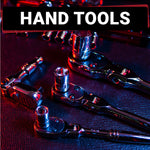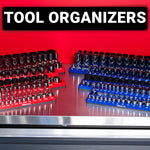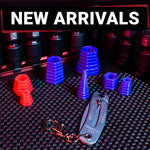Technicians require torque wrenches that reliably tighten bolt heads to specific torque ratings. Since torque wrenches slowly lose accuracy, you should regularly calibrate them.
Many people send their torque tools to professional calibration services, but you can calibrate them at home to maintain accurate performance. Whether you work in a professional setting or at home, follow these steps to calibrate a click-type or beam-style torque wrench.
Step 1: Clean the Torque Wrench
Dirt, rust, and grime affect torque wrench accuracy. Use a clean microfiber cloth to wipe the full length of the wrench. Pay extra attention to the adjustment knob, scale markings, and ratchet head. A light application of WD-40 on the cloth works for stubborn grease spots.
For the internal components, spray compressed air into the ratchet head mechanism to remove dust and debris. Never submerge your torque wrench in water or cleaning solutions, as it can damage internal parts.
End each cleaning session with a light coat of tool oil on a cloth to protect against corrosion. The oil creates a protective barrier without affecting torque readings.
Step 2: Set Up Your Test Area
Select a solid workbench or table for your tools. Add a non-slip mat to keep the equipment steady. Gather these calibration tools:
- Bench vise
- Weight set with known values
- Measuring tape
- Basic calculator
- Non-slip mat
Clear all extra tools from your work area. Mount the vise at the workbench edge so the torque wrench handle extends past it. Then, place the square drive into the vise and tighten. The vise should grip the wrench firm enough to hold it steady but not crush it. The wrench arm should extend parallel to the floor.
Room temperature affects calibration accuracy. The best calibration temperature is typically between 60–80°F (15–27°C). Cold conditions reduce accuracy and can damage internal components.
Step 3: Test Current Accuracy
A precise torque reading starts with measuring the lever length. The lever length starts at your square drive (where sockets attach) and extends to the handle's grip point. Measure the distance from the socket connection to where you apply force on the handle. Record this measurement.
Decide on a specific torque value to test, ideally around the middle of the wrench's range. Use the formula:
Desired torque/Wrench length = Test weight
Example: To test 40 ft-lbs (foot-pounds) with a 24-inch wrench
40 ÷ 24 = 1.67 lbs
Always follow torque specifications from your vehicle manual. This guarantees accurate readings for each fastener. Also, make sure the weight is securely attached to the handle's grip point to prevent accidents.
Attach your calculated weight at the handle's grip point. A properly calibrated wrench clicks right as the weight pulls down. An early or late click signals incorrect calibration.
Test multiple torque settings to verify consistent accuracy. Start at the lowest setting, then test the middle range, and finish with maximum torque. Record each result. Three successful tests at each setting confirm the accurate calibration of torque wrenches.
Note: Keep units consistent in calculations. Convert measurements as needed:
- 1 foot = 12 inches
- 1 ft-lb = 12 inch-pounds
- 1 ft-lb = 1.356 Newton meters
Step 4: Adjust the Spring Tension
After testing your torque wrench's accuracy, adjust its spring tension to correct discrepancies. Wear gloves during adjustments to maintain a firm grip on wrenches and avoid slips.
Follow these steps:
- Locate the adjustment mechanism: Most torque wrenches have an adjustment screw or mechanism on the handle. Check your manual to find its exact location.
- Adjust the spring tension: A late-clicking wrench requires clockwise turns of the adjustment screw. An early-clicking wrench requires counterclockwise turns. Stick to small, precise turns throughout calibration. Test the torque reading after each adjustment. The wrench must click exactly at your target torque setting before moving to the next step.
- Secure the adjustment: After calibration, tighten all adjustment mechanisms.
Step 5: Store Your Torque Wrench
Your torque wrench needs proper storage for reliable accuracy and to extend its service life. Always return the torque setting to its minimum value before storage. This removes unwanted tension from the internal springs that affect calibration.
Choose high-quality tool organizers to shield your torque wrench from dust, moisture, and accidental drops. Select a cool, dry storage location away from direct sunlight and temperature changes.
Handle your torque wrench with care to prevent damage. Accidental drops and impacts will ruin calibration. Keep the case in a secure spot where other tools cannot fall on it or knock it over.
These calibration steps apply to click-type and beam torque wrenches. Click-type wrenches signal with a snap or click at the target torque. Beam-style wrenches use a pointer against a scale. Electronic and digital torque wrench calibration requires professional service because of their complex internal mechanisms.
What Is the “20 Rule” for Torque Wrenches?
The “20 rule” states that torque wrenches must operate between 20–100% of their maximum torque rating for accurate readings. A torque wrench rated for 100 ft-lbs should not measure anything below 20 ft-lbs.
For example:
- A 100 ft-lb torque wrench provides reliable torque readings between 20–100 ft-lbs
- A 50 ft-lb torque wrench measures correctly between 10–50 ft-lbs
- A 250 ft-lb torque wrench stays accurate from 50–250 ft-lbs
Torque wrenches lose accuracy at settings under 20% of their max rating. Using a torque wrench below this threshold can damage or under-tighten components.
Select a torque wrench with a maximum rating that puts your target torque values in the middle of its range. This provides the most accurate readings and protects your tools and components.
How To Use a Torque Wrench
A torque wrench gives you the exact pressure for tightening fasteners. Under-tightened fasteners come loose. Over-tightened fasteners break or strip threads.
- Set your torque value on the handle. The measurement marks must line up perfectly.
- Push your socket onto the square drive until it locks.
- Place the wrench at a right angle to your fastener.
- Apply smooth, steady pressure until you hear or feel the torque wrench click.
Reset your torque wrench to zero after each use. Store it in its case to keep the calibration accurate for your next job.
Torque Wrench FAQ
What are the different types of torque wrenches?
There are a few different torque wrench types:
- Click-type wrenches signal with a snap when reaching set torque.
- Beam-type torque wrenches use a pointer against a scale.
- Digital and electronic wrenches display readings on a screen.
How long do torque wrenches stay accurate?
Regular use leads to torque loss over time. A torque wrench needs calibration after 5,000 cycles or one year of use. Frequent calibrations give you peace of mind that your tool will work accurately for a long time. Professional mechanics check calibration every six months. Drops, impacts, and improper storage speed up torque loss. A cheap torque wrench will also lose accuracy faster.
Why do electronic wrenches need professional calibration?
Digital and electronic torque wrench calibration requires the specialized testing equipment of a calibration lab. Internal sensors measure torque readings precisely, but incorrect calibration creates safety issues when working on fasteners. A professional engineer must verify and adjust these complex electronic mechanisms. Home calibration methods cannot properly test these sensitive measurement systems.
What is the difference between a “bench vice” and a “bench vise”?
A “bench vice” and a “bench vise” refer to the same tool used for holding workpieces securely. The term "vice" is the British English spelling, while "vise" is American English.
Can I use a breaker bar instead of a torque wrench?
No. Breaker bars break loose tight fasteners but cannot measure force. You need a torque wrench to apply the correct torque to fasteners. A breaker bar serves a different purpose; it loosens stubborn bolts and nuts with extra leverage.








